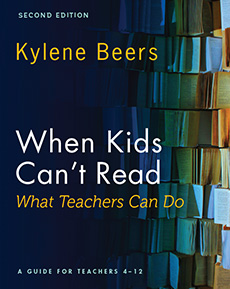An Enhanced Edition of ‘When Kids Can’t Read’
When Kids Can’t Read—What Teachers Can Do (2nd Edition)
By Kylene Beers
(Heinemann, 2023 – Learn more)
Reviewed by Pam Hamilton

Kylene Beers’ suggestions are very practical and “kid tested,” so you can confidently give them a try in your classroom. They also just make sense! Fun Fact: this book is often used as a textbook in teacher prep programs.
The first edition of When Kids Can’t Read—What Teachers Can Do was written more than 20 years ago now. It was nearing the twentieth anniversary when Beers was persuaded to write a second edition. She says that it’s more of a new edition than a second edition. In her words:
This revision reflects more definitive thoughts about the teaching of reading and why reading is necessary to the preservation of our democracy.
In the prologue, I believe she explains working with our striving readers perfectly (by the way, this quote was also in the first edition!):
There is no one answer to understanding why an adolescent has difficulties with reading. For there to be only one answer, there would have to be only one cause, and for there to be one cause, all students would have to be alike, learn alike, and have had the same experiences.
…it is critical that we understand that different students will require different types of help.
Can I get an “Amen”??!! :)

Now, twenty years later, schools face public criticism and new demands regarding phonics instruction and standardized testing as a result of reports, blog posts, news articles, and social media campaigns from science-of-reading advocates. The more things change, the more they stay the same.
There’s an old saying, “If it ain’t broke, don’t fix it,” but I would have to say in the case of this second edition, that just doesn’t hold true. “Make it new” is the saying to use here.
One of the new features is an “If, But, Then, See” chart on the inside front cover of the book. This is a quick guide for teachers to find the answers they need for a student. Beers understands that teachers don’t have time to read this book from cover to cover, so she gives you this chart to streamline your problem solving. For instance, if a student can recognize sight words but has difficulty discussing the text, then this student needs help with:
- Making inferences
- Making predictions
- Questioning the text
- Monitoring their own understanding
- Using fix-up strategies
- Visualizing
One of my favorite features of the original book is still in the new edition: Beers’ letters to George. She keeps the letters structure, but the letters themselves are new. We learn that George is a real student from her first year of teaching. She kept a journal that first year and was able to write the new letters from the notes she kept!
The first edition contained 15 chapters; the new edition contains 20. Some of the differences, besides changes to the chapters themselves, include dividing the book into four parts: Reading Matters; Comprehension; Word Work; and Making Reading Matter. Each section begins with an “If, But, Then, See” chart.
Reading Matters, Comprehension, Word Work and Making Reading Matter
In Part 1, Reading Matters, there is a four-page table comparing skilled to unskilled readers. This gives you a chance to think of yourself as a reader alongside a few of your students. Then you can begin to think of ways you can begin to move your students from the unskilled list to the skilled list.
The second section, Comprehension, contains many practical ideas you can use right away with your students. For instance, there is a two-page chart of types of inferences and how to help students (pp 57-58). But wait! Then, on pages 59-76, Beers shares more information about the different types of inferences and ways to help you teach them.
It’s important to note that she makes it clear you shouldn’t set out to teach all of the different types of inferences. You need to listen to your students and notice what inferences they’re making or failing to make – notice their “confusions” – then use the information in this part to help clear up those confusions.
Beers has also included helpful references to and suggestions from her books Notice & Note and Disruptive Thinking within this section.
Section three, Word Matters, talks about tier 1, tier 2 and tier 3 vocabulary. You will also find helpful scaffolds for pre-teaching vocabulary, which we know is one of the best ways to help students with comprehension of a particular text.
We need to make sure we’re pre-teaching the right words. Beers spends time in Chapter 11 helping you learn how to find the “right” words to pre-teach. There is also an entire chapter dedicated to phonics – something entirely necessary for a book written for this grade level.
The final section, Making Reading Matter, contains a chapter on “The Interdependent Relationship of Skill and Will.” This chapter talks about self-efficacy, self-concept and anxiety. As with the other chapters, Beers takes you inside a classroom and explains useful, practical tools you can use with your students straightaway.
This section also includes a chapter on questioning and how important different types of questions can be. There’s a chart showing the characteristics of monologic and dialogic talk. She gives three steps to help you encourage dialogic talk in your classroom. She also incudes three pages of dialogic questions at the end of the section to encourage student discussion and thought.
And, finally, Beers gives us tools to help students find a book. You may be tempted to skip this part – you’ve read all the tricks, right? Don’t do it! Read her suggestions. You won’t be sorry.
If you have the first edition of When Kids Can’t Read, I’m sure I don’t have to tell you that you should get this book. If you never read the first edition, now’s your chance to get out and get it. I don’t think you’ll be disappointed!
Pam Hamilton is an intermediate literacy coach and interventionist in Middlebury, Indiana. She is a trained Reading Recovery teacher and has been in education for over 28 years – the majority of that time having been spent in literacy intervention. Research is her “jam,” as she spends a significant amount of time in books and on the internet searching for the most up-to-date, relevant literacy information to share with teachers, fellow coaches and administrators. She enjoys working alongside teachers as they instill a love of literacy in their students.






























